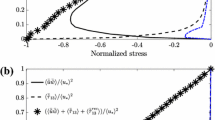Abstract
Different parameterizations of subgrid-scale fluxes are utilized in a nonhydrostatic and anelastic mesoscale model to study their influence on simulated Arctic cold air outbreaks. A local closure, a profile closure and two nonlocal closure schemes are applied, including an improved scheme, which is based on other nonlocal closures. It accounts for continuous subgrid-scale fluxes at the top of the surface layer and a continuous Prandtl number with respect to stratification. In the limit of neutral stratification the improved scheme gives eddy diffusivities similar to other parameterizations, whereas for strong unstable stratifications they become much larger and thus turbulent transports are more efficient. It is shown by comparison of model results with observations that the application of simple nonlocal closure schemes results in a more realistic simulation of a convective boundary layer than that of a local or a profile closure scheme. Improvements are due to the nonlocal formulation of the eddy diffusivities and to the inclusion of heat transport, which is independent of local gradients (countergradient transport).
Similar content being viewed by others
References
Bigalke, K.: 1992, ‘A New Method for Incorporating Point Sources into Eulerian Dispersion Models’, In: van Dop, H. and G. Kallos (ed.): Air Pollution Modelling And its Application IX,Plenum Publishing Corporation, New York, pp. 651–660
Blackadar, A.K.: 1962, ‘The vertical distribution of wind and turbulent exchange in a neutral atmosphere’, J. Geophys. Res. 67, 3095–3102
Brummer, B.: 1993, ARKTIS 1993, Report on the Field Phase with Examples of Measurements, Berichte aus dem ZMK, Hamburg 11, 186 pp.
Chrobok, G., Raasch, S., Etling, D.: 1992, ‘A Comparison of Local and Nonlocal Turbulence Closure Methods for the Case of a Cold Air Outbreak’, Boundary-Layer Meteorol. 58, 69–90
Deardorff, J.W.: 1966, ‘The Countergradient Heat Flux in the Lower Atmosphere and in the Laboratory’, J. Atmos. Sci. 23, 503–506
Deardorff, J.W.: 1972, ‘Theoretical Expression for the Countergradient Vertical Heat Flux’, J. Geophys. Res. 77, 5900–5904
Deardoff, J.W.: 1973, ‘The Use of Subgrid Transport Equations in a Three-dimensional Model of Atmospheric Turbulence’, J. Fluids Engr. 95, 429–438
Dunst, M.: 1982, ‘On the Vertical Structure of the Eddy Diffusion Coefficient in the PBL’, Atmosph. Environ 16, 2071–2074
Dyer, A.J.: 1974, ‘A Review of Flux-Profile Relationship’, Boundary-Layer Meteorol. 7, 362–372
Ebert, E.E., U. Schumann, and Stull, R.B.: 1989, ‘Nonlocal Turbulent Mixing in the Convective Boundary Layer Evaluated from Large-Eddy Simulation’, J. Atmos. Sci. 46, 2178–2207
Hartmann, J.: 1990, ‘Airborne Turbulence Measurements in the Maritime Convective Boundary Layer’, Thesis, School of Earth Sciences of the Flinders University, Australia, 162 pp.
Hartmann, J., C. Kottmeier, and S. Raasch: 1995, ‘Boundary Layer Deveploment and Roll Vortex Structure during a Cold Air Outbreak’, in preparation
Herbert, F.and Kramm, G.: 1985, ‘Trockene Deposition reaktionsträger Substanzen, beschrieben mit einem diagnostischen Modell der bodennahen Luftschicht’, Published in: Becker, K.H. and J. Löbel (Ed.): Atmosphärische Spurenstoffe und ihr physikalisch-chemisches Verhalten., Springer Verlag, Berlin, 264 pp.
Holtslag, A.A.M. and Moeng, C.H.: 1991, ‘Eddy Diffusivity and Countergradient Transport in the Convective Atmospheric Boundary Layer’, J. Atmos. Sci. 48, 1690–1698
Holtslag, A.A.M. Boville, B.A.: 1993, ‘Local versus Nonlocal Boundary-Layer Diffusion in a Global Climate Model’, J. Climate 6, 1825–1842
Kapitza, H. and Eppel, D.: 1987, ‘A 3-d. Poisson Solver Based on Conjugate Gradients Compared to Standart Iterative Methods and its Performance on Vector Computers’, J. Comp. Phys. 68, 474–484
Kottmeier, C., Hartmann, J., Wamser, C., Bochert, A., Lüpkes, C., Freese, gnD., Cohrs, W.: 1994, Radiation and Eddy Flux Experiment 1993 (REFLEX II), Reports on Polar Research, AWI Bremerhaven 133, 62 pp.
Niemeier, U. Schlünzen, K.H.: 1993, ‘Modelling Steep Terrain Influences on Flow Pattern at the Isle of Helgoland’, Beitr. Phys. Atmosph. 66, 45–62
Orlanski, I.: 1976, ‘A Simple Boundary Condition for Unbounded Hyperbolic Flows’, J. Comp. Phys. 21, 251–269
Priestley, C.H. and Swinbank, W.C.: 1947, ‘Vertical Transport of Heat by Turbulence in the Atmosphere’, Proc. Roy Soc. A189, 543–561
Schlünzen, K.H.: 1988, Das mesoskalige Transport- und Strömungsmodell 'METRAS — Grundlagen, Validierung, Anwendung -, Hamburger Geophysikalische Einzelschriften A88, 139 pp.
Schlünzen, K.H.: 1990, ‘Numerical Studies on the Inland Penetration of Sea Breeze Fronts at a Coastline with Tidally Flooded Mudflats’, Beitr. Physik Atm. 63, 254–256
Schlünzen, K.H.: 1994, ‘Atmosphärische Einträge von Nähr- und Schadstoffen’, in: Lozán, J.L.; E. Rachor; K. Reise; H. v. Westernhagen; W. Lenz (eds.): Warnsignale aus dem Wattenmeer — Wissenschaftliche Fakten. Blackwell Wissenschafts-Verlag, Berlin, 45–48
Schlünzen, K.H. and Krell, U.: 1994, ‘Mean and Local Transport in Air’, in: Sündermann, J. (ed.): Circulation and Contaminant Fluxes in the North Sea. Springer Verlag, 317–344
Schlünzen, K.H. and Pahl, S.: 1992, ‘Modification of Dry Deposition in a Developing Sea-Breeze Circulation — a Numerical Case Study’, Atmosph. Environ. 26A, 51–6
Schmidt, H. and Schumann, U.: 1989, ‘Coherent Structure of the Convective Boundary Layer Derived from Large-Eddy-Simulations’, J. Fluid Mech. 200, 511–562
Schumann, U.: 1987, ‘The Countergradient Heat Flux in Turbulent Stratified Flows’, Nucl. Eng. and Design 100, 255–262
Shapiro, R.: 1971, ‘The Use of Linear Filtering as a Parameterization of Diffusion’, J. Atmos. Sci. 28, 523–531
Stull, R.B. and Driedonks, A.G.M.: 1990, ‘Applications of the Transilient Turbulence Parameterization to Atmospheric Boundary-Layer Simulations’, Boundary-Layer Meteorol. 43, 209–239
Troen, I.B. and Mahrt, L.: 1986, ‘A Simple Model of the Atmospheric Boundary Layer; Sensitivity to Surface Evaporation’, Boundary-Layer Meteorol. 37, 129–148
Wu, Z. and Schlünzen, K.H.: 1992, ‘Numerical Study on the Local Wind Structures Forced by the Complex Terrain of Qingdao Area’, Acta Meteorologica Sinica 6, 355–366
Wyngaard, J.C. and Brost, R.A.: 1984, ‘Top-Down and Bottom-Up Diffusion of a Scalar in the Convective Boundary Layer’, J. Atmos. Sci. 41, 102–112
Author information
Authors and Affiliations
Rights and permissions
About this article
Cite this article
Lüpkes, C., Schlünzen, K.H. Modelling the arctic convective boundary-layer with different turbulence parameterizations. Boundary-Layer Meteorol 79, 107–130 (1996). https://doi.org/10.1007/BF00120077
Accepted:
Issue Date:
DOI: https://doi.org/10.1007/BF00120077




